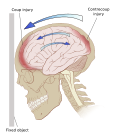Coup contrecoup injury
Coup and contrecoup injuries are types of traumatic brain injuries (TBI) that occur as a result of a forceful impact to the head. These injuries are characterized by damage to the brain on both the site of impact (coup injury) and the opposite side of the brain (contrecoup injury). This article will delve into the mechanisms, symptoms, diagnosis, and treatment of coup and contrecoup injuries, as well as their implications for affected individuals.
Mechanism of Injury[edit]
Coup and contrecoup injuries occur when the force of an impact causes the brain to move inside the skull. In a coup injury, the brain is injured directly under the site of impact, while a contrecoup injury occurs on the side opposite the impact. This movement can cause the brain to collide with the internal bony structures of the skull, leading to bruising (contusion), bleeding (hemorrhage), and tissue damage.
These injuries are commonly seen in situations involving rapid acceleration or deceleration of the head, such as in vehicle accidents, falls, or sports-related impacts. The severity of the injury can vary widely, depending on the force of the impact and the individual's specific circumstances.
Symptoms[edit]
Symptoms of coup and contrecoup injuries can range from mild to severe and may include:
- Headache
- Confusion
- Dizziness
- Nausea or vomiting
- Loss of consciousness
- Memory disturbances
- Mood changes
- Sensory deficits
- Motor deficits
The symptoms experienced can provide clues about the severity and location of the brain injury.
Diagnosis[edit]
Diagnosis of coup and contrecoup injuries typically involves a combination of clinical assessment and imaging studies. A thorough medical history and physical examination are essential to assess the extent of the injury and rule out other conditions. Imaging techniques such as CT scans or MRI are crucial for visualizing the brain and identifying areas of damage.
Treatment[edit]
Treatment for coup and contrecoup injuries varies based on the severity of the injury. Mild injuries may only require rest and monitoring, while more severe injuries could necessitate medical or surgical intervention to relieve pressure inside the skull, repair skull fractures, or address other complications. Rehabilitation services, including physical therapy, occupational therapy, and speech therapy, may be necessary to help the individual regain function and independence.
Prognosis[edit]
The prognosis for individuals with coup and contrecoup injuries depends on the severity of the injury, the speed of intervention, and the individual's overall health. While some may recover fully, others may experience long-term effects, such as cognitive deficits, physical impairments, or emotional and behavioral changes.
Prevention[edit]
Preventing coup and contrecoup injuries involves taking measures to protect the head from impacts. This includes wearing appropriate safety equipment during sports and recreational activities, using seat belts in vehicles, and ensuring safe environments to reduce the risk of falls.
Conclusion[edit]
Coup and contrecoup injuries are serious conditions that require prompt medical attention. Understanding the mechanisms, symptoms, and treatment options for these injuries is crucial for effective management and recovery. With appropriate care and rehabilitation, many individuals can make significant recoveries, though challenges may persist for some.
-
Contrecoup injury illustration
-
Coup injury illustration
Ad. Transform your life with W8MD's Budget GLP-1 injections from $75


W8MD offers a medical weight loss program to lose weight in Philadelphia. Our physician-supervised medical weight loss provides:
- Weight loss injections in NYC (generic and brand names):
- Zepbound / Mounjaro, Wegovy / Ozempic, Saxenda
- Most insurances accepted or discounted self-pay rates. We will obtain insurance prior authorizations if needed.
- Generic GLP1 weight loss injections from $75 for the starting dose.
- Also offer prescription weight loss medications including Phentermine, Qsymia, Diethylpropion, Contrave etc.
NYC weight loss doctor appointmentsNYC weight loss doctor appointments
Start your NYC weight loss journey today at our NYC medical weight loss and Philadelphia medical weight loss clinics.
- Call 718-946-5500 to lose weight in NYC or for medical weight loss in Philadelphia 215-676-2334.
- Tags:NYC medical weight loss, Philadelphia lose weight Zepbound NYC, Budget GLP1 weight loss injections, Wegovy Philadelphia, Wegovy NYC, Philadelphia medical weight loss, Brookly weight loss and Wegovy NYC
|
WikiMD's Wellness Encyclopedia |
| Let Food Be Thy Medicine Medicine Thy Food - Hippocrates |
Medical Disclaimer: WikiMD is not a substitute for professional medical advice. The information on WikiMD is provided as an information resource only, may be incorrect, outdated or misleading, and is not to be used or relied on for any diagnostic or treatment purposes. Please consult your health care provider before making any healthcare decisions or for guidance about a specific medical condition. WikiMD expressly disclaims responsibility, and shall have no liability, for any damages, loss, injury, or liability whatsoever suffered as a result of your reliance on the information contained in this site. By visiting this site you agree to the foregoing terms and conditions, which may from time to time be changed or supplemented by WikiMD. If you do not agree to the foregoing terms and conditions, you should not enter or use this site. See full disclaimer.
Credits:Most images are courtesy of Wikimedia commons, and templates, categories Wikipedia, licensed under CC BY SA or similar.
Translate this page: - East Asian
中文,
日本,
한국어,
South Asian
हिन्दी,
தமிழ்,
తెలుగు,
Urdu,
ಕನ್ನಡ,
Southeast Asian
Indonesian,
Vietnamese,
Thai,
မြန်မာဘာသာ,
বাংলা
European
español,
Deutsch,
français,
Greek,
português do Brasil,
polski,
română,
русский,
Nederlands,
norsk,
svenska,
suomi,
Italian
Middle Eastern & African
عربى,
Turkish,
Persian,
Hebrew,
Afrikaans,
isiZulu,
Kiswahili,
Other
Bulgarian,
Hungarian,
Czech,
Swedish,
മലയാളം,
मराठी,
ਪੰਜਾਬੀ,
ગુજરાતી,
Portuguese,
Ukrainian


